Journées du Patrimoine, European Heritage Days: Not-to-Miss Sites in Paris
- SUBSCRIBE
- ALREADY SUBSCRIBED?
BECOME A BONJOUR PARIS MEMBER
Gain full access to our collection of over 5,000 articles and bring the City of Light into your life. Just 60 USD per year.
Find out why you should become a member here.
Sign in
Fill in your credentials below.
The Journées du Patrimoine occurs on the 3rd weekend of September each year and is a must for anyone that loves Paris history and architecture. Historic buildings that are usually closed to the public are open to visitors, free of charge. If you want to take a peek into the Palais de l’Élysée, home of the French president, or maybe even behind the velvet curtain of the Crazy Horse Paris cabaret, then this is the weekend for you.
Organized by the Minister of Culture, each year has a specific theme. For the 36th anniversary this year, the theme is arts and entertainment. Specific themed cultural events will be held at various locations throughout France. However, the highlight of the entire weekend is getting past the façade of some of the most stunning buildings in Paris. Serious planning has to go into the weekend; the lines can be long and the opening hours variable.

The Senate. Photo: Claudine Hemingway
One year, on the top of my list to see was the Palais de l’Élysée. I was dying to see inside the palace that was bought by Louis XV and given to his mistress, the Marquise de Pompadour, and would later serve as the home for the French head of state. I was not the only one that had this idea. A few thousand other history-loving friends did as well. After arriving very early and standing in line for over 90 minutes, I reached a sign that said, “If you are here, it will be 4 hours until you arrive at the Élysée”. At that time, I jumped the fence and headed towards another location. As much as I would like to see the inside of the palace, wasting the whole day was not my idea of a good time. For Heritage Days weekend, that is the worst case scenario.
Although, going in with a plan is essential. Prior to the weekend, the catalog created by the Minister of Cultural can be picked up at their office as well as lists and info on their website. All openings and events are free, but a select few require a reservation that must be obtained in advanced and very limited. Embassies, government buildings and hôtel particuliers that are only open for this weekend, should be at the top of your list. Churches and museums that are normally open year-round often have special tours and events this weekend. A visit to the crypt of Saint-Sulpice, a close up look at the organ of Notre-Dame-des-Blancs-Manteaux and even concerts in many of the beautiful stained glass churches. Here are a few of my top picks that you should not miss.
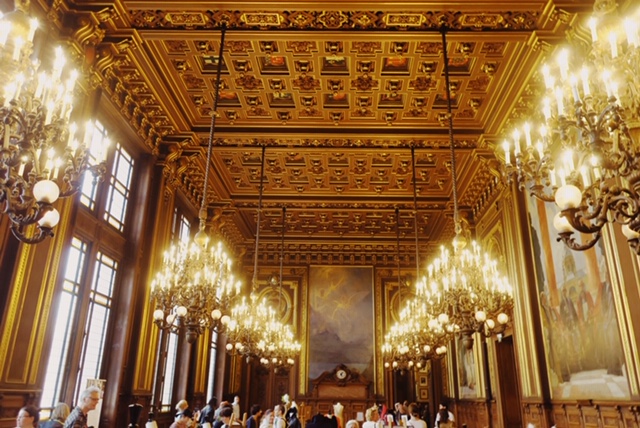
Hôtel de Ville de Paris. Photo: Claudine Hemingway
Hôtel de Ville de Paris, at 31 rue Lobau in the 4th arrondissement: This is the main city hall for Paris and office of Paris Mayor Anne Hidalgo. Aside from that, the building holds a story that stretches back through two incarnations of the same building. The original building was built by François I, added onto by Henri IV, and stood until 24 May 1871. During the Paris Commune, it would be set ablaze, burning for several days. The entire contents was destroyed including the paintings by Eugene Delacroix in the Salle de la Paix. On 10 August 1871, it was voted to rebuild the Hôtel de Ville, reviving the Renaissance façade just as it was. Eleven years later, the new and present Hôtel de Ville would be reopened and on this special weekend, you are in for a real treat.
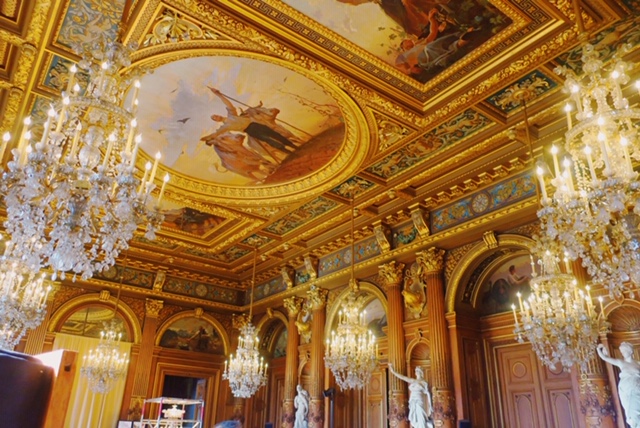
Hôtel de Ville de Paris. Photo: Claudine Hemingway
The self-guided tour winds you through ceremonial staircase, Salon des arcades, Salle des fêtes, Salon Georges Bertrand and even the mayor’s office. Each room is also dedicated to the many craftsman that make France so special. Locksmiths that can still work on 16th century locks, chandelier makers and stone cutters. It is in these rooms that you will appreciate that France still holds these crafts so dear and will continue to renovate and save so many of its historic structures. Arrive a bit early before the doors open, and make sure to look up at the façade and the statues of the great men of art, letters and history that wrap around the building.
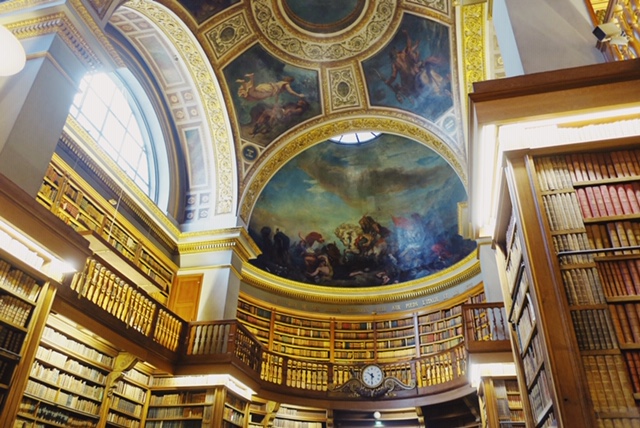
Assemblée Nationale. Photo: Claudine Hemingway
Many of the government buildings never started out that way. Take for instance l’Assemblée Nationale. Before it was the site of the French National Assembly it was the Palais Bourbon, home to Louise Françoise de Bourbon, daughter of Louis XIV and Madame de Montespan. A simple little county house surrounded by gardens. Built in 1726, it was located on the edge of Paris and designed after the Grand Trianon of Versailles. Jules Mansart and three other architects that kept dying before the designs were finished would complete the plans of the palace. Her lover the Comte de Lassay would build a palace next to hers, the Hôtel de Lassay, and the Palais Bourbon are now connected and part of the Assemblée National today. This is another tour you will want to arrive early for; just grab a croissant for the wait and enjoy. The interiors are breathtaking.
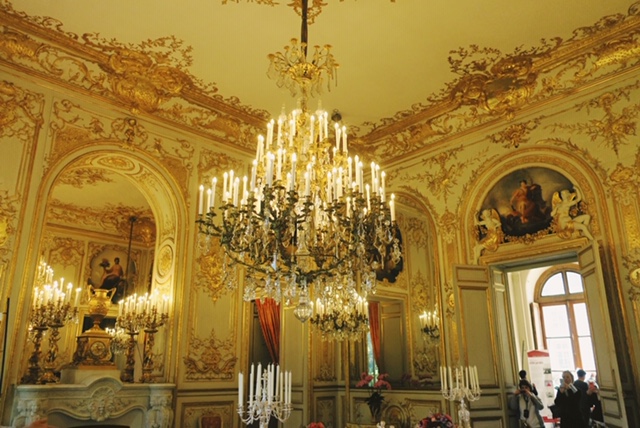
Assemblée Nationale. Photo: Claudine Hemingway
One of the first rooms you will enter is the Salon Delacroix. In 1833, the Minister of the Interior, Adolphe Thiers commissioned Eugène Delacroix to decorate the Salle du Roi. The young painter, only 25 at the start of the project, would beautifully add his Romanticism style to the walls of the room that was seen by every visitor that arrived. With allegories between the windows of Oceanus, Mediterranean Mare, industry, justice, agriculture and the war. Be sure to look up, around the room, over the windows. Delacroix would also add his touches to the cupola of the library.
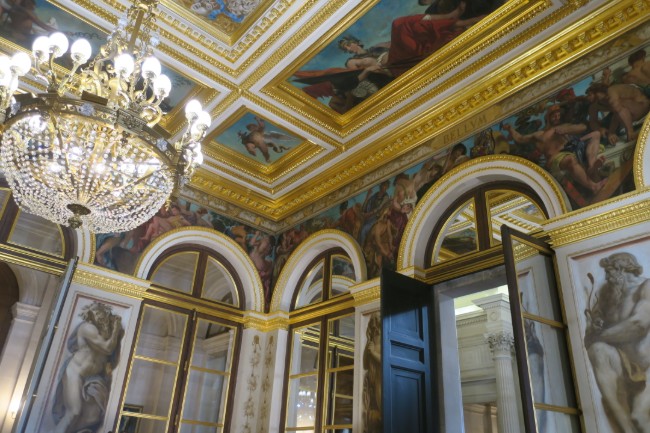
Salon Delacroix at the Assemblée nationale. Photo: Claudine Hemingway
The tour continues through the assembly room that is still used today, with its red velvet seats. The Hôtel de Lassay holds the grander spaces, if that can even be imagined. The Salle des Fêtes et Galerie des Tapisseires, Salon and Cabinet du Départ are set for a lavish dinner. If only you could take a seat and have a coupe of Champagne. The tour finishes walking through the vast garden, that you can picture the two lovers strolling through.

Senate ceiling. Photo: Claudine Hemingway
While the Jardin du Luxembourg is one of the most beautiful parks in all of Paris, it is the palace that sits center stage. Built by the widowed queen, Marie de Medici who wanted a little piece of her childhood home of Florence, the Palazzo Pitti, in Paris. She sent her architect Clément Métezeau to Florence to take detailed sketches. Upon his return she had many Italian artisan employed to carry out her grand vision. Moving in to the partially finished palace in 1625, she was able to see the instillation of the Medici Cycle by Peter Paul Rubens. The 24 paintings depicting and rewriting the biggest events of her life took only three years for Rubens to paint. (Today these paintings are in the Musée du Louvre, but avoid a visit until late October. One of my favorite rooms in all of the Louvre is now the temporary home of the Mona Lisa.) In 1632, after a falling out with her son that had come of age now to rule, she was forced out of her beloved and still unfinished home.
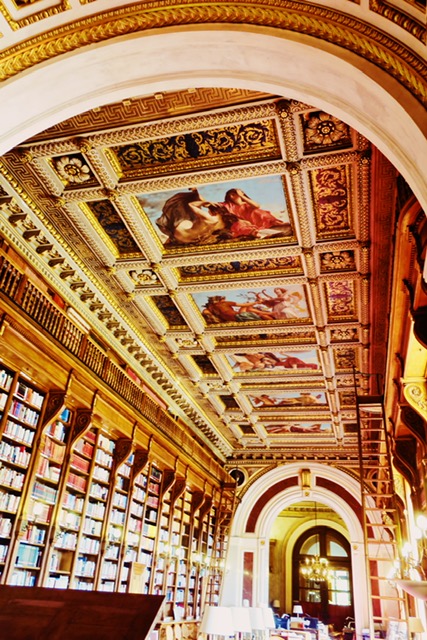
Senate library. Photo: Claudine Hemingway
Today the palace is the location of the Senate but many of the rooms still hold the opulence it had under Medici. In 1793, it served as a prison during the revolution and in 1795, it was the seat of power for the Senate. Both Bonapartes would add their golden touches and the glistening Second Empire is still very evident today. The Conference hall holds the throne used by Napoleon Bonaparte. While you are captivated by the golden sphinxes, look up. The arches at either end are decorated with the history of France by Henri Lehmann. Saint Louis, Francois I, Jeanne d’Arc and the ruling monarchy families that ruled France for hundreds of years. In the Livre d’or, you will get an idea of what the palace looked like when it was the home of Medici as it has remained mostly untouched. Delacroix would spend five years painting the dome in the library. Depicting the Canto IV from Dante’s Infero, as the poet is welcomed by Homer in Limbo, and meets Aristotle, Plato, Socrates, Caesar and Cicero. Delacroix had a great affinity for the great murals that could be added to the public places and saw them as a legacy that would live forever. So thankful we still have so many of them.
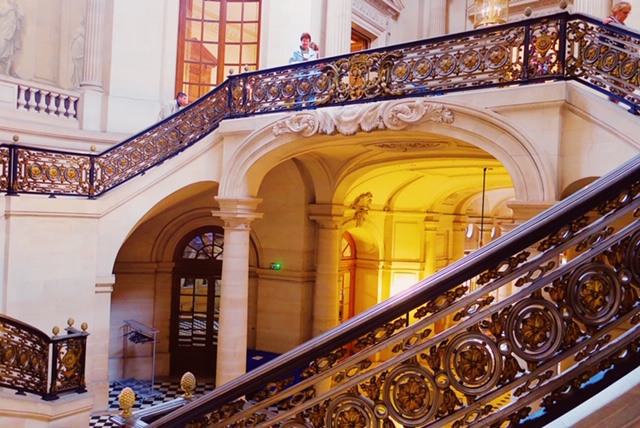
Staircase in the Palais Royal. Photo: Claudine Hemingway
Just across from the Musée du Louvre sits the former palace of Cardinal Richelieu. What many will know from the often-photographed black and white columns and peaceful gardens: the Palais Royal. Today it holds the Conseil d’État, Ministry of Culture and the Constitutional Council and is jaw dropping to see in person. In 1629 the influential and wealthy Cardinal Richelieu wanted a home built in close proximity to the Louvre and king Louis XIII. French baroque architect Jacques Lemercier designed the palace, keeping in mind the many rooms needed to show off the Cardinal’s vast art collection. Completed in 1939, the Cardinal would only enjoy three short years here before he passed away in 1642. Following his death, it was turned over to the King and was renamed Palais Royal. The young King Louis XIV lived many years here with his mother Ann of Austria and another Cardinal, Mazarin. The palace today, hidden away from our curious eyes most of the year, holds room after room of splendor and plenty of golden details.
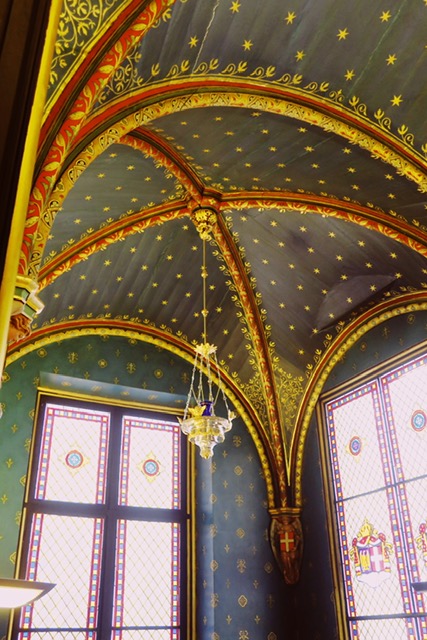
Chape Napoleon. Photo: Claudine Hemingway
First you’ll pass through the offices of the Ministry of Culture, the organizers of this Heritage Days weekend. Much of the original layout of the previous purpose is still intact. The Salon Jérôme, with its many mirrors, reflects the light and gilded walls. The Grand Salon, with its immense chandeliers, leads you to one of the prettiest staircases in Paris. The ceremonial staircase of the Conseil d’État with its double flights that wind to the upper landing built by Contant d’Ivry in 1765. As you walk through each room, you will pass spaces that are well lived in with desks covered with paper as people had left them on Friday before the start of the weekend. Off one of the offices is a tiny and lovely little chapel, built for Prince Napoleon and Princess Maria Clotilde when they lived for a time here. It is unchanged from the time they worshipped here. Each room you walk through is filled with details that harken back to its former residence.
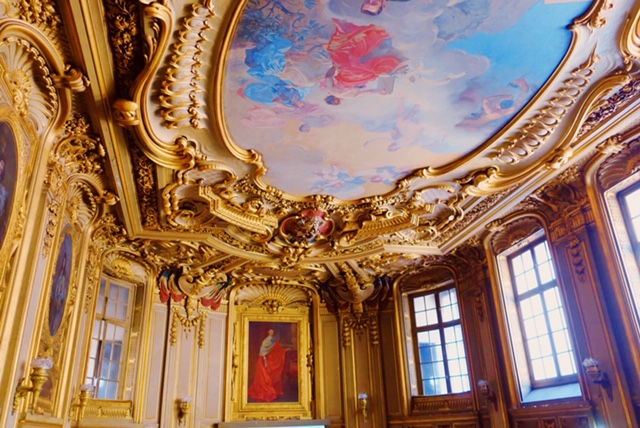
Sorbonne. Photo: Claudine Hemingway
Speaking of Richelieu: The Sorbonne, or the University of Paris as it is known today, sits in the Latin Quarter, the hotbed of intellectual Paris. Founded in 1253 by Robert de Sorbon in the outskirts of St Germain. In 1257 Louis IX, later to be Saint Louis, appointed Sorbon as his confessor and also giving the school added influence. Four hundred years later, it would be a former student that would propel the school to its height for higher learning. Cardinal Richelieu and his architect Lemercier had a new façade redesigned and the chapel that would serve as the Cardinal’s final resting place.

The tomb of Cardinal Richelieu. Photo: Claudine Hemingway
In 1901 another architect would breathe new life into the Sorbonne that over time had been left abandoned during the Revolution. Henri-Paul Nénot would redesign every building of the University of Paris but one, the Art & Archaeology Institute. Today on the tour, you travel back through many incarnations. The Staircase of the Arts and the Peristyle is worth the visit alone. The walls are covered with large paintings of the history of France. I spent well over an hour soaking in every detail. Continuing through the Grand Salon, Louis Liard doctoral room and amphitheaters that just the day before was filled with students.
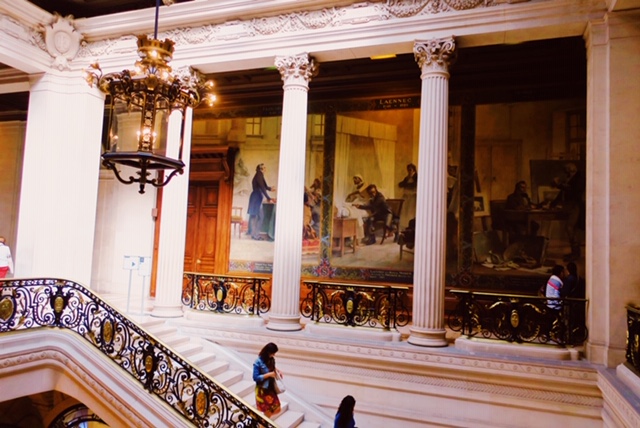
Sorbonne. Photo: Claudine Hemingway
The Sorbonne and all its rooms are lovely, but there was one man and space I wanted to see more than any of it. The Cardinal Richelieu was a fascinating figure. Rumored to be the father of Louis XIV, the complex and interesting man that collected art and statues now held within the Louvre has always peeked my interest. Inside the Sorbonne Chapel under the two faced dome in the choir is the tomb of Richelieu. Created by François Girardon from 1675 to 1694, it captures the moment of his last breath. Atop his tomb is the Cardinal surrounded by two allegories. Piety who is holding him up and crying at his feet, Doctrine. Saved during the Revolution it was moved to the Musée des Monuments until Louis XVIII had it returned to the church.
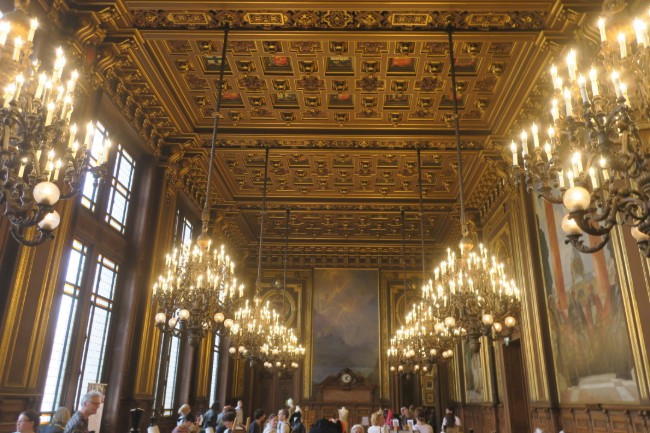
Sorbonne. Photo: Claudine Hemingway
On the left bank opposite the Musée du Louvre and the Pont des Arts is the domed wonder that is the Institut de France. Originally the Collège des Quatre-Nations created by Cardinal Mazarin, after his predecessor Richelieu had reestablished the Sorbonne. Mazarin also wanted a space for his large collection of books and a chapel for his final resting place. Louis Le Vau architect to the King who would design the extension of the Palais du Louvre, Vaux-le-Vicomte and Versailles was tasked with creating the building for Mazarin. It was built at the edge of the Seine where the wall of Philippe Auguste ended and the former Tower of Nesle once stood. The dome and façade by Le Vau includes the founder’s name in Latin and topped with the lantern and dome with just enough gold that glistens during the early morning Paris sunrise. This has been one of my very favorite churches in all of Paris from my very first trip. Its location so close to the Louvre and the Pont des Arts, but it is the view from behind on Rue Mazarine is the one I have to see as soon as I arrive in Paris. The quiet street closed to traffic is always empty, but as you get closer, the gold shines a little brighter in the sunshine and welcomes me home.
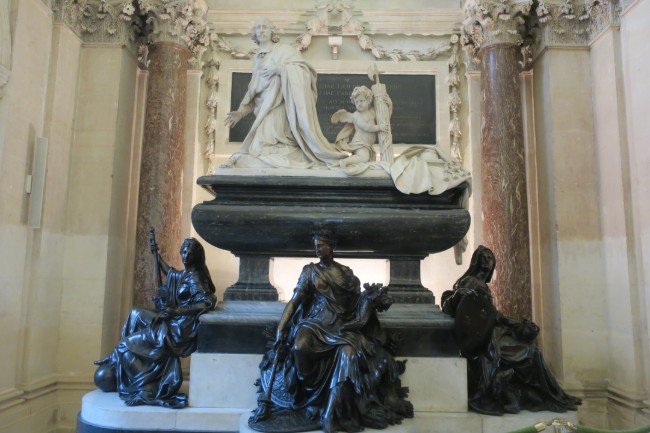
Tomb of Mazarin. Photo: Claudine Hemingway
Inside the chapel that is now used for the public sessions of the Académie Française, is the tomb of Mazarin. Sculpted in 1693 by Antoine Coysevox in white marble, it shows the Cardinal on his knees with a cherub behind him on top of his tomb. Below he is guarded by the bronze allegories of Prudence, Fidelity and Peace by Étienne Le Hongre and Jean-Baptiste Tuby. I find great peace visiting the tombs that were created for these amazing characters in French history. Grandiose and beautiful with every detail thought out is all part of their story, long after their death.
The Bibliothèque Mazarin with its endless shelves of books, each one historical in its own right, many of which owned by Mazarin is worthy of an hour of your time just looking at each shelf. Filled with marble busts between each shelf, the dark wood and light from the high windows take you back a few centuries. Be sure to catch a glimpse out the window before you leave of the Pont des Arts and the Louvre before you venture through the rest of this beautiful building.
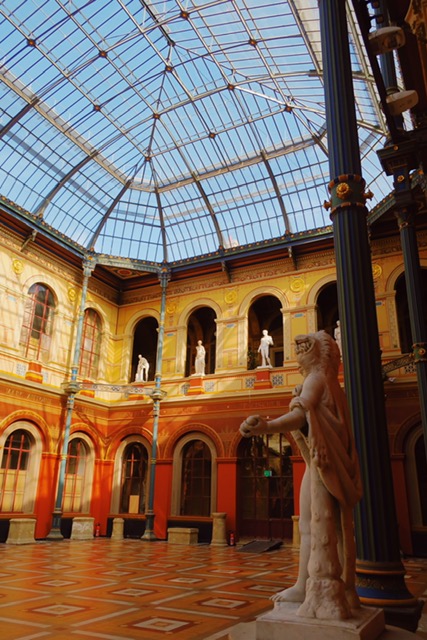
École des Beaux Arts. Photo: Claudine Hemingway
Other can’t-miss sites include: the École des Beaux Arts where many of the great artists of France have all attended; the Hôtel de Toulouse-Banque de France (1st arrondissement), boasting a hall of mirrors that could rival Versailles; the Bibliothèque Saint-Geneviève near the Pantheon and the BNF Richelieu, each with amazing ceilings that take much of the attention away from the books that line the walls.
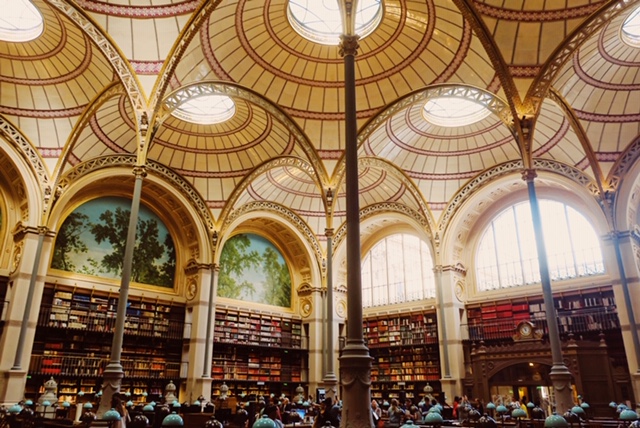
BNF Richelieu. Photo: Claudine Hemingway
I could go on forever about these treasures of Paris that are open only one weekend a year. Each one with its own story and history to share for those that take the time to stop and really look. It is a busy weekend– you’ll need to bring patience– but it’s worth it.
Lead photo credit : Salon Delacroix at the Assemblée nationale. Photo: Claudine Hemingway
More in European Heritage Days, free activities in Paris, free stuff in Paris, Journées du Patrimoine, Paris sightseeing
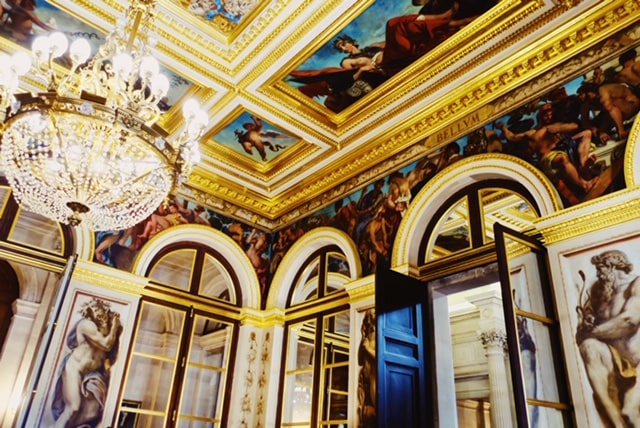

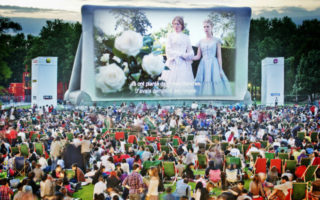


REPLY